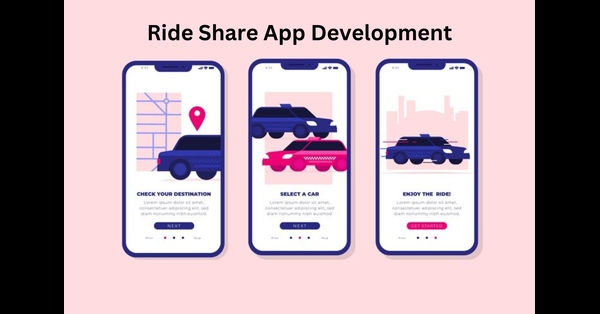Ride Sharing App Development: Future, Trends, and Development Cost
The demand for ride-sharing apps has been on the rise, and it’s not difficult to see why. They’ve made commuting more convenient, cost-effective, and efficient. But what does the future hold for ridesharing app development? How are trends shaping the industry? And, most importantly, what does it cost to develop such an app?
In this article, I’ll dive deep into the future of ride-hailing apps, the key trends you should be aware of, and the costs associated with developing one, based on my research and experience.
The Future of Ridesharing App Development
As per my research, the future of ridesharing app development looks incredibly promising. The global ride-hailing market was valued at around $113 billion in 2021, and it’s expected to reach nearly $230 billion by 2028. That’s a huge leap, fueled by advancements in technology, user preferences, and the push towards sustainability.
Here are a few key factors shaping the future:
1. Electric Vehicles (EVs) in Ride-Hailing
The future of ride-sharing will increasingly revolve around electric vehicles (EVs). Governments and companies alike are pushing for greener alternatives. Companies like Uber and Lyft have already committed to going fully electric by 2030. This means that ridesharing app development services will need to integrate features to support EVs, like finding charging stations or calculating optimized routes for electric vehicles.
2. Autonomous Vehicles
As autonomous vehicle technology advances, it will eventually become a crucial part of ride-hailing. Imagine hailing a ride without a driver—sounds futuristic, right? However, companies like Waymo and Tesla are actively working to make this a reality. Ride-hailing app development will need to adapt to this trend by including functionalities for autonomous vehicle management, customer communication, and safety monitoring.
3. Shared Rides and Sustainability
More and more users are becoming environmentally conscious, and shared rides are becoming a preferred option. It not only reduces the cost for passengers but also minimizes carbon emissions. This trend pushes ridesharing app development services to focus on building algorithms that can efficiently match passengers going in the same direction.
4. Enhanced Safety Features
Post-pandemic, safety remains a top priority. Future ridesharing app development will emphasize features like real-time background checks of drivers, contactless payment options, and in-app emergency buttons. As I found over research, users now expect more transparency regarding their driver’s background, vehicle condition, and even cleanliness standards.
Key Trends in Ride-Hailing App Development
Based on the data available, several trends are shaping the current landscape of ride-hailing apps, and they are likely to dominate the industry moving forward.
1. AI and Machine Learning
Artificial intelligence (AI) and machine learning (ML) are at the forefront of ride-hailing app development services. These technologies are essential in creating better route optimization, predictive maintenance for vehicles, and even fraud detection. AI-driven algorithms also enhance the passenger experience by providing faster matching with drivers and dynamic pricing models.
2. Blockchain Integration
Blockchain technology offers solutions for many challenges in the ride-hailing industry, such as data privacy, payment security, and driver-passenger disputes. Some ride-hailing app development companies are exploring blockchain for decentralized platforms, where drivers and passengers connect directly without a third-party middleman.
3. On-Demand Services
As per my experience, the idea of on-demand services is expanding beyond just rides. Some companies are merging ride-hailing with other services like food delivery or grocery shopping. This means that ridesharing app development services now have to support multiple functionalities, providing users with a one-stop solution for all their needs.
4. Subscription Models
Subscription services in ride-hailing apps are becoming more common. Companies like Uber are offering subscriptions that provide discounted fares and priority booking. This trend will require ride-hailing app development to create systems that track usage and provide dynamic benefits for users.
5. Customization and Personalization
The more personalized the user experience, the more loyal the customer. As per my research, ride-hailing app development companies are now focusing on personalizing the user experience through AI, offering users personalized recommendations based on their ride history, preferences, and travel habits.
Development Cost of Ride-Hailing Apps
Now, let’s address the big question: How much does it cost to develop a ride-hailing app?
From my experience and the available data, the cost of ridesharing app development can vary significantly, depending on several factors. Here’s a breakdown of the primary factors that affect the cost:
1. App Complexity
The complexity of your app will largely determine the cost. A simple ride-hailing app with basic features like booking, fare calculation, and driver tracking can cost between $30,000 and $50,000. However, if you want advanced features like AI integration, multi-language support, or blockchain implementation, the cost could rise to $100,000 or more.
2. Platform (iOS, Android, or Both)
As I found over research, choosing the platform for your app also impacts the cost. Developing for both iOS and Android will obviously be more expensive than choosing just one. If you’re looking for a cross-platform app that works on both, the cost might range from $40,000 to $80,000, depending on the framework you choose.
3. Design
A well-designed app is critical for user experience, but it comes at a price. Custom design elements, interactive features, and smooth user interfaces will increase the cost. For ridesharing app development, a high-end design could add $10,000 to $30,000 to your budget.
4. Third-Party Integrations
Integrating third-party services like payment gateways, maps, or even customer support chat can increase the overall development cost. For instance, integrating secure payment gateways like PayPal or Stripe might cost an additional $5,000 to $10,000.
5. Development Team
The location and expertise of your development team can dramatically influence the cost. Hiring a top-tier ride-hailing app development company in the US or Europe might cost more than hiring a company in regions like Southeast Asia or Eastern Europe. However, the latter could still deliver high-quality work at a fraction of the cost, sometimes as low as $25,000.
6. Maintenance and Updates
Once your app is launched, it’s essential to maintain and update it. This could cost between 15% and 20% of the original development cost annually. Regular updates to fix bugs, add new features, or adapt to new operating system updates are essential to staying competitive.
Conclusion
Ridesharing and ride-hailing app development is a fast-evolving field, filled with innovation and opportunity. Whether you’re looking to build a simple app or something more advanced, understanding the trends and future of the industry is crucial.
As per my research, with the right ride-hailing app development company, the initial investment can offer huge returns as the market continues to grow. Whether you’re interested in building an app that focuses on electric vehicles, autonomous driving, or even blockchain, the key is to stay ahead of the trends. While the cost of ridesharing app development services might seem steep initially, the long-term benefits and scalability make it a worthwhile venture.
If you’re thinking about stepping into the world of ride-hailing app development, now might be the perfect time. As the industry continues to evolve, those who innovate early will be best positioned to succeed in this competitive market.













Post Comment